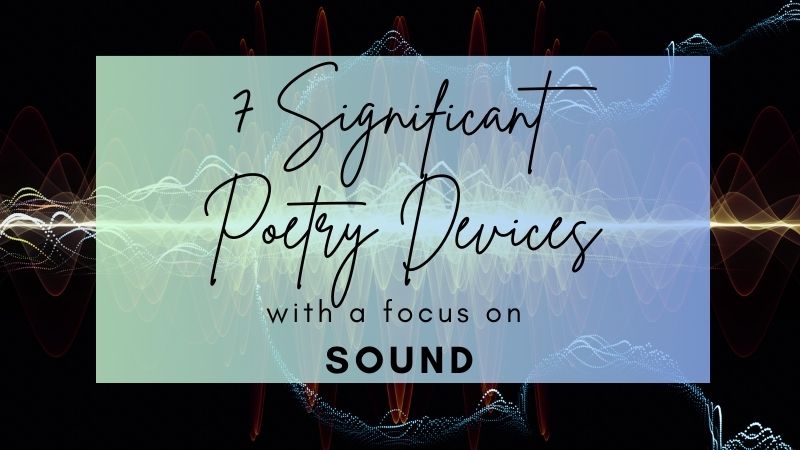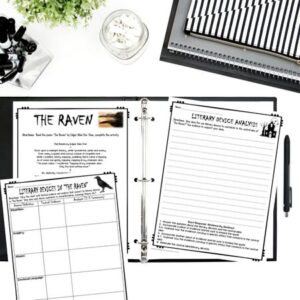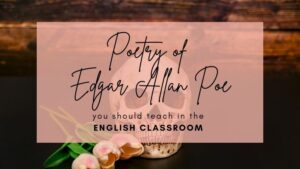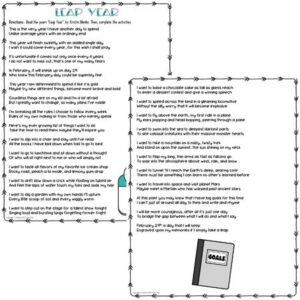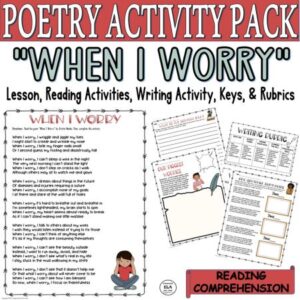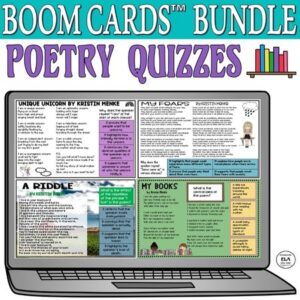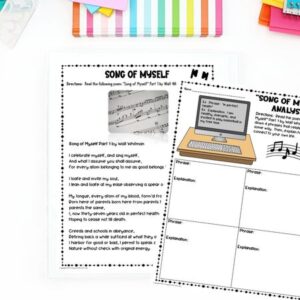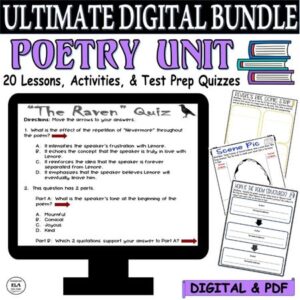I love poetry, but I understand that I am in the minority here. Most students when asked to read poetry instantly become like deer in the headlights. And a part of the reason is because of the structure of poems from free verse to those that use poetry devices sound elements in some way!
And that is okay!
Reading poetry should be fun and NOT a laborious experience for the teacher or her/his students! If you take the time to teach poetry devices sound related or otherwise, however, your students might understand certain poems a bit better.
Over time, you might even have some aspiring poets on your hands!
Keep reading for 7 Significant Poetry Devices Sound Elements to include in your poetry lessons!
Need help with Test Prep? Check out this FREE Pack of 3 Test Prep Activities to help students achieve success on standardized tests!

What are Poetry Devices Sound Elements?
Teaching poetry devices sound elements seems simple because it is, but it can still be a challenge! Certain poetry devices relay specific sounds for VERY specific reasons. Poetry devices sound elements are not arbitrary.
A poet was clearly very purposeful in including these poetry devices sound connected for a reason! Teaching these devices helps our students build a toolbox of sorts for poetry analysis and poetry writing!
As you teach poetry, take the time to define, analyze, provide examples, and practice with these poetry devices sound techniques!
7 Significant Poetry Devices Sound Elements
1. Rhyme (Internal/End)
Rhyme is the most obvious element that students recognize and can dive into with a poem, especially with end rhyme where the last word in a line rhymes across several lines often in a predictable pattern. Most likely, students enjoy the rhyme device the most because of rhyming poems in the elementary grades.
Many forms of poetry use rhyme effectively, including sonnets, villanelles, and sestinas. Consider adding Shakespeare’s sonnets to your lesson plans. You can focus on the rhyme scheme and the distinct 4-4-4-2 line structure of these 14-line poems!
Internal rhyme, where a word in the middle of a line rhymes with a word at the end of a line, is a bit more of a challenge for students. But if you’ve taught anything by Edgar Allan Poe then you could bring in “The Raven” as a complement to it.
With lines such as “While I nodded, nearly napping, suddenly there came a tapping, / As of some one gently rapping, rapping at my chamber door,” this poem is sure to delight students as they track the rhymes – end and internal – that Poe uses.
Want some fun ideas for teaching poetry devices sound elements in poems by Edgar Allan Poe? Click below!
2. Rhythm
The beat and pace of a poem are often created through word choice and rhyme scheme. For example, this resource with a poem for leap year uses a series of rhyming couplets.
This is the very year I have another day to spend
Unlike average years with an ordinary end
This year will finish sweetly with an added single day
I wish it could come every year; for this wish I shall pray
It’s unfortunate it comes out only once every 4 years
I do not want to miss out; that’s one of my many fears
In February, it will sneak up on day 29
Who knew this February day could be superbly fine
This year I am determined to spend it like it is gold
Maybe try new different things, become more brave and bold
Finish the poem: HERE
Your students can focus on the poem’s rhythm and rhyme scheme, as well as summary skills and making personal connections to the content!
3. Meter
This is the number of syllables and the pattern of these syllables in a line. Examples abound within Shakespeare where he writes often with lines that feature a series of stressed and unstressed syllables – iambic pentameter – where each set is called a foot to create a line with 5 feet.
In fact, you could embed the teaching of poetry devices sound elements as you read Romeo and Juliet!
The Prologue from Romeo and Juliet
Two households, both alike in dignity
(In fair Verona, where we lay our scene),
From ancient grudge break to new mutiny,
Where civil blood makes civil hands unclean.
5 From forth the fatal loins of these two foes
A pair of star-crossed lovers take their life;
Whose misadventured piteous overthrows
Doth with their death bury their parents’ strife.
The fearful passage of their death-marked love
10 And the continuance of their parents’ rage,
Which, but their children’s end, naught could remove,
Is now the two hours’ traffic of our stage;
The which, if you with patient ears attend,
What here shall miss, our toil shall strive to mend.
Provide students with the same sonnet (or the Prologue) you use in teaching rhyme and ask them to mark out the meter. Which syllables do they think are stressed or unstressed? The easiest way to figure this out is to say the poems out loud. This could lead to a poetry cafe where students in small groups read sonnets to each other (or even specific lines) to track the meter.
Coffee and Poetry are the perfect pairing!!
4. Alliteration
Alliteration occurs when a line offers the repetition of a letter at the start of words in close succession. This is a favorite and often one that students will have a great familiarity with. As a result, you may want to increase the challenge for them to examine alliteration in poems such as “The Raven” by Edgar Allan Poe or “Birches” by Robert Frost.
This other poem below, “When I Worry” by Kristin Menke, incorporates alliteration as well as rhyme throughout:
When I worry, I wriggle and jiggle my toes
I might start to crinkle and wrinkle my nose
When I worry, I bite my finger nails small
Or I second guess my footing and disastrously fall
Check out the whole poem here>>> “When I Worry”
Alliteration: when/worry, finger/footing/fall
Rhyme: wriggle/jiggle, toes/nose, crinkle/wrinkle, small/fall
With consistent exposure, students will start to see alliteration EVERYWHERE!
With this EASY-TO-TEACH Lesson Packet, you can practice with your students, so they will feel more confident analyzing poetry!
5. Assonance
Like alliteration, assonance is the repetition of sounds, but this time it occurs with vowel sounds within words that are close to each other.
One poem that embodies the use of assonance (and consonance) is “There Will Come Soft Rains” by Sara Teasdale. Provide a copy of the poem to students and ask them to go through it and highlight or underline examples of assonance.
You can take it a step further after their initial notice-and-note and get them to switch the lines to different sounds. How might they shift from what Teasdale has to something that sounds similar with a different sound? Or something that sounds completely opposite with a different sound? Students will be able to better understand the effect of Teasdale’s choices and the difficulty of these choices.
Have you ever used BOOM Cards(TM) to teach poetry? Check out this bundle below!
6. Consonance
Consonance is the repetition of consonant sounds within words that are close together. Since consonance can go hand-in-hand with assonance, it’s great to pair the two together in a lesson or activity.
Case in point, you can use an excerpt from Walt Whitman’s “Song of Myself!” Students can explore alliteration and assonance and, with a different color, ask them to highlight or underline examples of consonance in the poem. Again, they can try to shift or swap out the current choices with their own.
Notice the use of the “s” sound here; it is actually quite soothing and peaceful as the speaker reflects on himself and his life:
I celebrate myself, and sing myself,
And what I assume you shall assume,
For every atom belonging to me as good belongs to you.
I loafe and invite my soul,
I lean and loafe at my ease observing a spear of summer grass.
Remember; we are not focusing on a specific letter, but a specific sound. It creates a seamless flow with an emphasis on the beauty and celebration of the individual.
There is always a purpose for using poetry devices sound elements and Whitman incorporates them effectively!
7. Tone
Tone is the poet’s attitude that can be gleaned by the reader of the poem. This tone may be about the poem’s speaker or subject matter. Tone is sometimes referred to as mood, but that would be the reader’s experience of the poem rather than trying to understand the poet’s purpose and craft.
To examine tone, start with obvious examples and then shift to more subtle ones when students gain experience and know-how. Poe’s poetry is a great starting point and the expected tone and mood of his works are likely familiar to students. Identifying the tone with examples directly pulled from the poems offers a chance to employ students’ close reading skills!
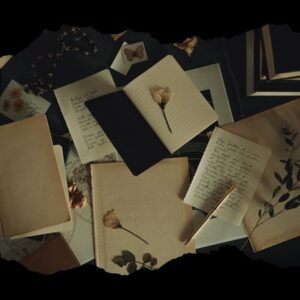
When you want to shift to more challenging poems use the search function on the Academy of American Poet’s website. Pick a theme and/or, time period, and use a keyword for the tone you want, and voila a ready-made list of poems to use with your students with a focus on poetry devices sound elements and tone!
You could even assign this activity as a mini-research project for students to find poems with a specific tone. Brainstorm a list of possible tones such as angry, sad, cheerful, optimistic, etc. Students can work independently to find poems and then meet in small groups based on the assigned tone to review their poems, identify the words/lines that create the tone, and then compare and contrast their different poems.
Why teach poetry devices sound elements?
We use various poetry devices sound techniques in how we talk, sing, give speeches, etc. We might not even realize how much sound and rhythm play a role in our everyday speaking lives!!
So spending time teaching about these concepts and the diverse poetic forms can ultimately help us to better understand ourselves!
POETRY RESOURCE
Do your students need help with reading test prep, but you want to be able to teach poetry you love that includes poetry devices sound elements? This DISTANCE LEARNING POETRY TEST PREP ULTIMATE BUNDLE contains 20 EASY-TO-TEACH Lessons, ENGAGING Reading Comprehension Activities, and STEP-BY-STEP Writing Responses! It includes quizzes that mimic standardized tests with QUESTIONS and ANSWERS (for 20 poems including “A Poison Tree,” “Annabel Lee,” “I Hear America Singing,” “The Raven,” “I Wandered Lonely as a Cloud,” etc.) based on the Common Core Reading standards!
Make teaching poems with poetry devices sound elements SIMPLE & EASY!
Want help with teaching poetry devices sound elements? Check out my store, Kristin Menke-Integrated ELA Test Prep!

